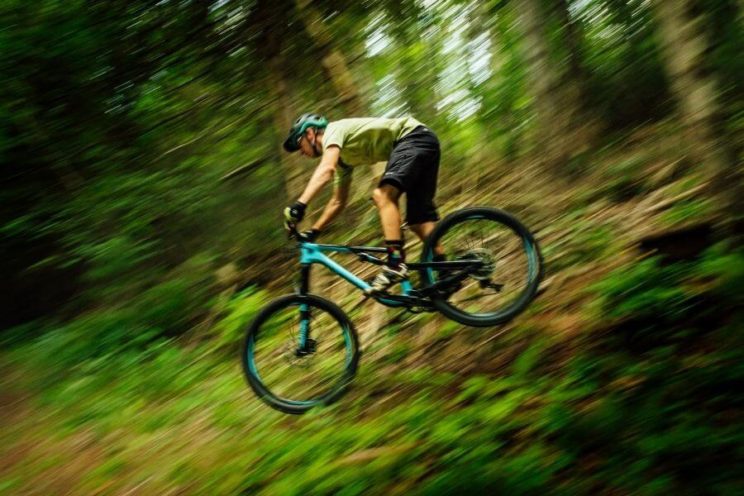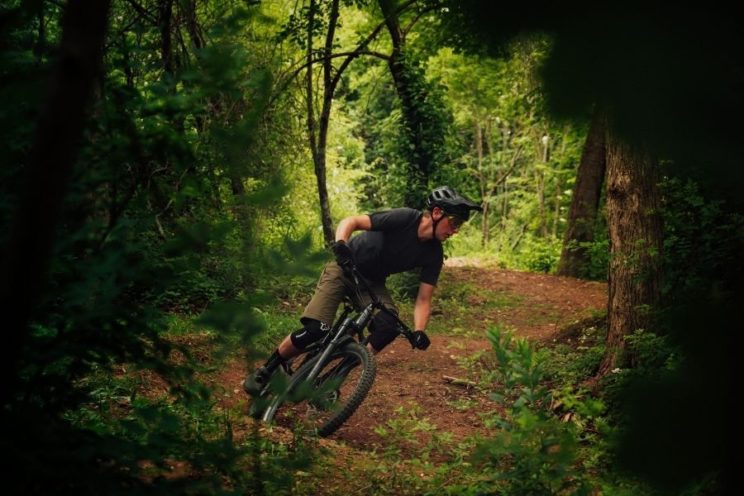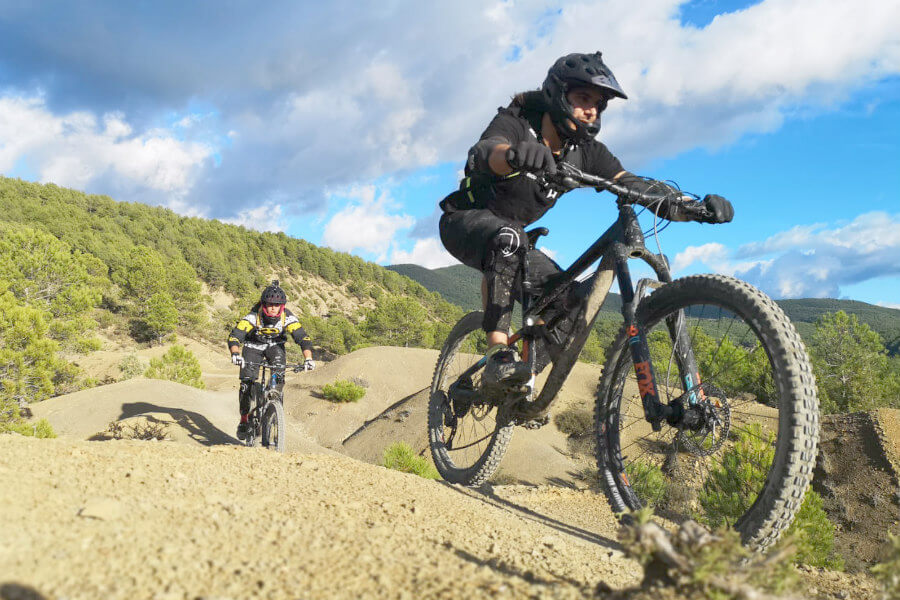The enduro is one of the most fun and with the highest level of adrenaline in the
Mountain Bike. But not everything is fun, especially for beginners. It is a modality that involves a lot of risk of falls and requires always being in great physical and mental form to fully enjoy it.
If you have decided to enter the enduro or bought yourself
A mountain bike of this modalityThe most important thing is to mentalize that the improvements in the physical and technical aspect do not appear overnight. You have to work every day through these tips that we list. All of them will be your decalogue of norms to become a real
Rider.
1. Do you have previous experience in the Mountain Bike?
If you have never practiced mountain cycling and you will make the direct jump to the enduro buying a double suspension bike and going down with it through the most steep and stony trialera on the mountain we recommend that you do not do it.
The enduro demands a good state in shape due to the strong slopes of the climbs and muscle wear of the descents, especially in trunk and arms. Is a
discipline of Mountain Bike which also requires having a good base in the handling of the mountain bike, such as knowing how to pass obstacles, rocks and small descents. It is convenient to have practiced
Cross country previously. He
Cross country It is less demanding in the physical and technical.

However, if you do not want to waste time and you are convinced that yours is to go down, start with simple low slope (-300 m) routes, with small clean, short and not very steep obstacles. Thus you will take confidence in the handling of the bicycle and you will not suffer as well and emotionally from the beginning.
2- Train the physical background
In the enduro, anaerobic intensity training, more than 180 pulsations per minute in small series, is not a priority. It doesn't matter so much speed and resistance. To be able to endure several hours by pedaling and overcoming long increases with very constant slopes, the most common of these routes.
Professional coach Alan Milway recommends in
Red Bull MTB Make outputs that last two hours, but always with a rhythm of low to moderate intensity. To guide you in your effort, we recommend that you buy a clock with built -in heart ratemeter, or one with chest sensor, to control your pulsations on the fly and do not exceed you with the rhythm. The margin on which you must move approximately is 130 to 160 pulsations per minute.
3- Always carry protections
Once we have uploaded to the top of the mountain and we get ready to start the descent it is essential to have the most sensitive parts of your body protected. Not only before possible falls, but also before blows with rocks, roots, branches, etc.
Use the front brake only when you go completely or in case of emergency if you leave the path, but never abruptly.
Both beginners and
RIDERS With experience they use helmets with additional protection for the neck, as well as for the temples. It is also highly recommended, almost mandatory, wearing knee stalls and codes. In this sense, not any knee and co -okay. In most physical or online cycling stores there are specific protections to endure with designs that do not bother to pedal (in the case of knee) and breathable tissues for heat days.
4- Moder the speed in the descents
Do not try to make the hero in the descents if you do not have much experience going down. Start the drop at contained speed, touching the rear brake softly and progressively, advancing at least 10 meters to anticipate obstacles or turns.

Remember that the rear brake is in charge of moderating the speed while the striker is the one that completely the bike. Use the latter only when you are going to stop or in case of emergency if you leave the path, but always do it progressively, never abruptly. Otherwise it is most likely that you shoot over the handlebar and suffer a significant fall.
5- Salt accompanied
Due to its risk of inherent fall it is better to start practicing enduro accompanied by others
RIDERS. Better if they already have experience. Let yourself be advised and make your first declines guiding you for one of them. The ideal is to start the last, guided 10 or 15 meters ahead of a partner who will indicate the easiest traced and warning you of the most difficult obstacles.
6- Train strength and increase muscle
In the enduro as important is training on the bicycle as outside it. Overcoming descents with obstacles and strong negative slope requires extra muscle strength in arms, trunk and legs.
Program an effective weight routine that forbid forearms, biceps, shoulders and back. Also another from Core, like this one that shows you in
Global Cycling Network, and legs. The help of a
personal trainer At this point it is highly recommended to progress properly and avoid the appearance of discomfort and injury.
7- Adapt your diet
A good enduro route of 3 or 4 hours and more than 2,000 meters of unevenness needs an extra contribution of nutrients so as not to faint. Feed yourself correctly before, during and after the exit, with a diet rich in protein to optimize muscle performance and carbohydrates that will provide you with extra energy during the route.
One of the moments of greatest adrenaline release comes when there is a jump, but we recommend you practice before in a more controlled environment like a Pump Track
Due to its long duration and that generally the best and longer declines are far from urban nuclei, in high mountain, we recommend you carry a hydration backpack. This will allow you to store more water (2 to 4 liters) than by carrying only one or two drums. It is also advisable to transport some sandwich, bars, gels, fruit, tools and a spare chamber to
Emergency repairs.
8- Low the descents in very pronounced
One of the basic tricks that everything
Rider Enduro puts into practice to descend with greater control and safety is to do it with the downstorm washing. With this you manage to throw your body back and lower the center of gravity with greater comfort.
In this way you distribute your body weight by moving it back, compensating for the strong inertia that will take the bike forward and facilitate control of it. To accelerate the lowering or updating operation you can install a bike on your bike
Telescopic Riper that goes up or down by acting a remote control in the handlebar by getting up or sitting in the armchair.
9- Avoid jumping
We know that one of the moments of greatest adrenaline liberation is to jump. And if you do it in the middle of a descent with a
double suspension bicycle This feeling multiplies. But we recommend that you practice before in a more controlled and clean environment, such as a
Pump Track, before jumping rocks on the mountain.

As a general rule, and to avoid a strong fall and probable injury, if there is an escape to the jump, use it. Otherwise you must moderate the speed with the rear brake without reducing it excessively from about 10 meters before reaching the jump.
Once you reach the jump ramp, your arms and legs slightly drive as if they were docks at the same time to keep the bicycle balanced during the jump and contact the ground (the so -called reception of the jump) with the two wheels to the time.
10- Relax your body and enjoy
As the last Technical Council for beginners in the Enduro of Mountain Bike, we recommend that you enjoy the descents. Not the most pronounced slopes with fear or grab your muscles. Firmly grab the handlebars but without exceeding, keep your eyes in front to anticipate the traced, brake in moderation and let the bicycle roll.
In this way you will be able to dominate your bicycle and direct it where you want, and not vice versa. Controlling this last aspect is vital to move on to the next level, which will imply increasing speed and daring with larger and more pronounced and long pending obstacles.
 However, if you do not want to waste time and you are convinced that yours is to go down, start with simple low slope (-300 m) routes, with small clean, short and not very steep obstacles. Thus you will take confidence in the handling of the bicycle and you will not suffer as well and emotionally from the beginning.
However, if you do not want to waste time and you are convinced that yours is to go down, start with simple low slope (-300 m) routes, with small clean, short and not very steep obstacles. Thus you will take confidence in the handling of the bicycle and you will not suffer as well and emotionally from the beginning.
 Remember that the rear brake is in charge of moderating the speed while the striker is the one that completely the bike. Use the latter only when you are going to stop or in case of emergency if you leave the path, but always do it progressively, never abruptly. Otherwise it is most likely that you shoot over the handlebar and suffer a significant fall.
Remember that the rear brake is in charge of moderating the speed while the striker is the one that completely the bike. Use the latter only when you are going to stop or in case of emergency if you leave the path, but always do it progressively, never abruptly. Otherwise it is most likely that you shoot over the handlebar and suffer a significant fall.
 As a general rule, and to avoid a strong fall and probable injury, if there is an escape to the jump, use it. Otherwise you must moderate the speed with the rear brake without reducing it excessively from about 10 meters before reaching the jump.
Once you reach the jump ramp, your arms and legs slightly drive as if they were docks at the same time to keep the bicycle balanced during the jump and contact the ground (the so -called reception of the jump) with the two wheels to the time.
As a general rule, and to avoid a strong fall and probable injury, if there is an escape to the jump, use it. Otherwise you must moderate the speed with the rear brake without reducing it excessively from about 10 meters before reaching the jump.
Once you reach the jump ramp, your arms and legs slightly drive as if they were docks at the same time to keep the bicycle balanced during the jump and contact the ground (the so -called reception of the jump) with the two wheels to the time.












